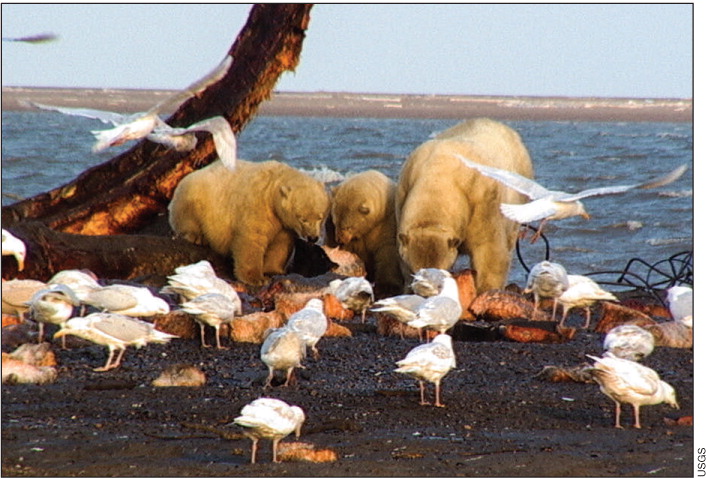New diseases travel on the wings of birds in a rapidly changing north

When polar bears meet glaucous gulls over the remains of a bowhead whale, they may be sharing more than a meal. As the warming climate brings animals into new proximity, parasites, viruses, and bacteria can find opportunities to spread to new and naïve hosts, sometimes jumping from birds to mammals, and from marine ecosystems to land ecosystems. Credit, USGS.
When wild birds are a big part of your diet, opening a freshly shot bird to find worms squirming around under the skin is a disconcerting sight. That was exactly what Victoria Kotongan saw in October, 2012, when she set to cleaning two of four spruce grouse (Falcipennis canadensis) she had taken near her home in Unalakleet, on the northwest coast of Alaska. The next day, she shot four grouse and all four harbored the long, white worms. In two birds, the worms appeared to be emerging from the meat.
Kotongan, worried about the health of the grouse and the potential risk to her community, reported the parasites to the Local Environmental Observer Network, which arranged to have the frozen bird carcasses sent to a lab for testing. Lab results identified the worms as the nematode Splendidofilaria pectoralis, a thinly described parasite previously observed in blue grouse (Dendragapus obscurus pallidus) in interior British Columbia, Canada. The nematode had not been seen before so far north and west. Though S. pectoralis is unlikely to be dangerous to people, other emerging diseases in northern regions are not so innocuous.

Adult female Splendidofilaria pectoralis nematodes squirm on the meat of a spruce grouse (Falcipennis canadensis). Victoria Kotongan shot six spruce grouse near her home in Unalakleet, on the remote northwest coast of Alaska one weekend in October, 2012. Four harbored visible worms under their skin. Filaroid nematodes had not been reported before in Alaskan grouse. Credit, Victoria Kotongan, Local Environmental Observer Network, Alaska Native Tribal Health Consortium.
Animals are changing their seasonal movements and feeding patterns to cope with the changing climate, bringing into close contact species that rarely met in the past. Nowhere is this more apparent than the polar latitudes, where warming has been fastest and most dramatic. Red foxes are spreading north into arctic fox territory. Hunger is driving polar bears ashore as sea ice shrinks. Many arctic birds undertake long migratory journeys and have the mobility to fly far beyond their historical ranges, or extend their stay in attractive feeding or nesting sites.
With close contact comes a risk of infection with the exotic parasites and microorganisms carried by new neighbors, and so disease is finding new territory as well. Clement conditions extend the lifecycles of disease carrying insects, and disease-causing organisms. Migratory birds can take infectious agents for rides over great distances. In November 2013, Alaska Native residents of St. Lawrence Island, in the Bering Sea, alerted wildlife managers to the deaths of hundreds of crested auklets, thick-billed murres, northern fulmars and other seabirds, caused by an outbreak of highly contagious avian cholera (Pasteurella multocida).
“It’s the first time avian cholera has shown up in Alaska,” said Caroline Van Hemert, a wildlife biologist with the U.S. Geological Survey in Anchorage, Alaska. “St. Lawrence Island is usually iced in by November, but last year we had a warm fall and winter in Alaska. We don’t know for sure that open water, climate, and high-densities of birds contributed to the outbreak, but it coincided with unusual environmental conditions.”
Circumstantial evidence collected by researchers and local observers is pointing toward a surge of infectious disease in the northern latitudes, but scanty baseline data makes interpretation of current trends uncertain. Van Hemert and colleagues review the state of our knowledge of emerging disease in northern birds and effects on wildlife and human health, discussing strategies for cooperative programs to fill in information gaps in the December issue of Frontiers in Ecology and the Environment.
 Wildlife health in a rapidly changing North: focus on avian disease. (2014) Caroline Van Hemert, John M Pearce, and Colleen M Handel. Frontiers in Ecology and the Environment, 12(10): 548–556, doi:10.1890/130291
Wildlife health in a rapidly changing North: focus on avian disease. (2014) Caroline Van Hemert, John M Pearce, and Colleen M Handel. Frontiers in Ecology and the Environment, 12(10): 548–556, doi:10.1890/130291